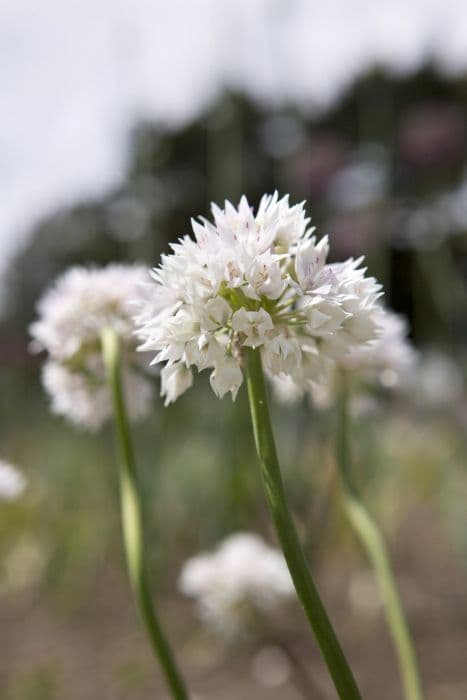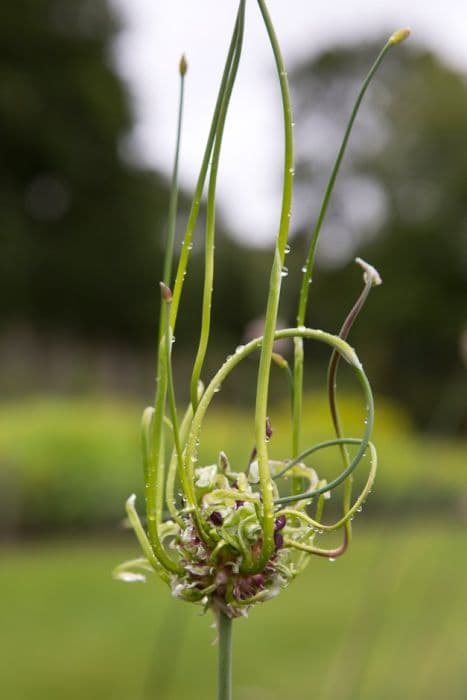Ornamental onion Allium atropurpureum

ABOUT
Allium atropurpureum, commonly known as the ornamental onion, is a captivating bulbous perennial. It boasts a striking appearance that comes to life in late spring to early summer. The plant displays dense, star-shaped flowers, which cluster together to form a globular inflorescence sitting atop a sturdy, upright stem. The color palette of these floral spheres is a rich and sumptuous wine-dark purple, often appearing almost black, lending a dramatic flair to any garden setting. The ornamental onion's leaves emerge at the base, creating a foliage backdrop mainly characterized by a bluish-green color. These leaves are typically long and strap-like, with a slightly glossy appearance, which can add textural contrast to surrounding plants. The flower heads, with their deep hues, not only create a visual statement but also attract numerous pollinators like bees and butterflies, adding life and movement to the garden. After blooming, the flowers maintain their structure and color, often persisting into the dryer months, providing continued interest even as other plants might start to fade.
About this plant
 Names
NamesFamily
Amaryllidaceae
Synonyms
Ornamental Onion, Purple Flowering Onion, Purple-flowered Garlic
Common names
Allium atropurpureum, Allium bourgaei, Allium paniculatum subsp. atropurpureum, Allium paniculatum var. atropurpureum.
 Toxicity
ToxicityTo humans
Allium atropurpureum, commonly known as ornamental onion, is not considered highly toxic to humans. However, consuming large amounts of this plant could potentially lead to gastrointestinal discomfort, such as nausea or diarrhea. There is a potential for an allergic reaction in some individuals, and handling the plant can sometimes cause skin irritation.
To pets
Ornamental onion is known to be toxic to cats and dogs. Members of the Allium genus contain compounds that can be harmful if ingested by pets. These compounds can cause oxidative damage to the red blood cells, leading to hemolysis or the breaking down of red blood cells, resulting in a condition known as hemolytic anemia. Symptoms of poisoning in pets include vomiting, diarrhea, abdominal pain, weakness, and possibly jaundice due to the reduction in red blood cells. In severe cases, ingesting ornamental onion can lead to organ damage or even be fatal if not treated promptly. Pet owners should ensure that these plants are kept out of reach of their animals.
 Characteristics
CharacteristicsLife cycle
Perennials
Foliage type
Deciduous
Color of leaves
Green
Flower color
Purple
Height
1-2 feet (0.30-0.61 meters)
Spread
0.5-1 feet (0.15-0.30 meters)
Plant type
Bulb
Hardiness zones
4
Native area
Europe
Benefits
 General Benefits
General Benefits- Ornamental Value: Adds visual interest to gardens with its deep purple, almost black flowers that bloom in late spring to early summer.
- Attracts Pollinators: Flowers provide nectar for bees, butterflies, and other beneficial insects, promoting biodiversity.
- Low Maintenance: Once established, it requires minimal care, making it ideal for gardeners who seek plants that do not need constant attention.
- Drought Tolerance: Adapts well to dry conditions, making it suitable for xeriscaping and water-wise gardens.
- Culinary Use: Some parts of the plant, such as the bulb, are edible and can be used in the same manner as other alliums like onions and garlic, contributing to a variety of dishes.
- Deer and Rodent Resistant: Its strong scent and taste tend to deter deer and rodents, protecting other plants in the vicinity.
- Easy to Propagate: Can be easily propagated through division or seed, allowing gardeners to expand their collection without significant expense.
 Medical Properties
Medical Properties- Anti-inflammatory: Allium atropurpureum may contain compounds that can help reduce inflammation.
- Antioxidant: The plant could have antioxidant properties due to its composition, potentially neutralizing free radicals in the body.
- Antimicrobial: There could be antimicrobial activity in the plant's extracts, which might help in fighting certain bacterial infections.
- Cardiovascular health: Some Allium species are known to have a positive effect on heart health, and Allium atropurpureum may share these properties.
 Air-purifying Qualities
Air-purifying QualitiesThis plant is not specifically known for air purifying qualities.
 Other Uses
Other Uses- Allium atropurpureum, commonly known as ornamental onion, can be used as a dye plant, offering a natural source of colors for fabrics and wool.
- The plant can serve as a companion plant in gardens, helping to repel certain insects and pests that are adverse to its scent.
- Dried ornamental onion flowers provide long-lasting decorative elements for floral arrangements and craft projects.
- The strong architectural stems and flowers can be used in landscape design to create focal points or contrast with softer plants.
- Allium atropurpureum seed heads can be spray-painted and used as unique elements in artistic installations or modern décor.
- The tall flowering stalks can be used in garden sculptures by weaving or tying them together in creative ways.
- Pressed and preserved Allium atropurpureum flowers can be used in botanical paper-making or to adorn handmade greeting cards.
- The plant's ability to attract pollinators makes it suitable for inclusion in butterfly or bee gardens.
- Allium atropurpureum can be planted as a natural border or edge in landscaping, providing a seasonal display of color and texture.
- Photographers and painters may use the striking appearance of Allium atropurpureum as a subject for artistic works, capturing its unique geometry and depth of color.
Interesting Facts
 Feng Shui
Feng ShuiThe plant name Allium atropurpureum, commonly known as ornamental onion, is not used in Feng Shui practice.
 Zodiac Sign Compitability
Zodiac Sign CompitabilityThe ornamental onion is not used in astrology practice.
 Plant Symbolism
Plant Symbolism- Unity and Patience: Like other members of the Allium family, the ornamental onion's spherical shape represents unity, suggesting that many separate parts come together to create a whole. This can symbolize the patience needed to see all the components of a situation or project come together harmoniously.
- Good Fortune: In some cultures, Alliums are believed to bring good luck due to their robust nature and long-lasting blooms, implying that the ornamental onion could be seen as a symbol of prosperity and enduring success.
- Strength and Courage: The sturdy stems and bold colors of Allium atropurpureum, the ornamental onion, reflect strength and courage. This symbolism might be drawn from the plant's ability to thrive in a variety of conditions, suggesting resilience in the face of challenges.
- Protection: The Allium genus has been used traditionally to ward off evil spirits or provide protection due to their strong, pungent odor. Therefore, ornamental onion may represent a protective amulet against negative forces.
 Water
WaterThe ornamental onion (Allium atropurpureum) prefers consistent moisture when in growth, but it is quite drought tolerant once established. Water the plant deeply to encourage root development, providing about 1 inch of water per week, depending on rainfall. During the active growing season in spring and early summer, you may need to water every week if there is no rain, but always check the soil moisture before watering – the soil should be moist but not waterlogged. Reduce watering after the flowers have bloomed and the leaves begin to yellow, as the plant enters dormancy. On average, this implies using about 0.5 gallons per square foot over a month during the growing season, adjustments should be made based on weather conditions and soil type.
 Light
LightOrnamental onions prefer full sun exposure and thrive in spots that receive at least 6 to 8 hours of direct sunlight daily. They perform best in well-lit areas where they can soak up the sun's rays, which encourages strong growth and better blooms. Partial shade is tolerated, especially in hotter climates where some afternoon shade can protect the plants from scorching.
 Temperature
TemperatureOrnamental onions are hardy and adapt well to a wide range of temperatures, generally growing best between 55°F and 75°F. They can withstand temperatures down to about 20°F when dormant in winter, and up to 90°F during the growing season, although prolonged heat can inhibit bloom. Ensure good air circulation to prevent fungal issues in high humidity and heat.
 Pruning
PruningPruning ornamental onions involves deadheading spent blooms to encourage bulb growth and tidiness. After flowering, cut back the flower stalks but leave the foliage until it completely dies back, as it provides energy for the bulb for next year. Pruning is generally done post-flowering and is not required often, typically once per season after the blooms have faded.
 Cleaning
CleaningAs needed
 Soil
SoilOrnamental onion (Allium atropurpureum) thrives in well-drained soil with a high proportion of organic matter. A good mix would combine two-parts garden soil, one-part sand or perlite, and one-part compost. The ideal soil pH for this plant is in the range of 5.5 to 6.5.
 Repotting
RepottingOrnamental onion bulbs should be repotted every three to four years or as needed when they become overcrowded. After blooming, when the foliage has died back, is the ideal time to repot or divide the bulbs.
 Humidity & Misting
Humidity & MistingOrnamental onion prefers dry to average humidity levels. It is quite tolerant of varying atmospheric moisture and does not require any special humidity adjustments.
 Suitable locations
Suitable locationsIndoor
Place in well-lit spot, water sparingly to avoid rot.
Outdoor
Full sun, well-drained soil, plant in autumn or spring.
Hardiness zone
4-8 USDA
 Life cycle
Life cycleAllium atropurpureum, commonly known as the purple-flowered onion, begins its life cycle when its seeds germinate in early spring, requiring a period of cold stratification to break dormancy. After germination, the plant develops a small bulb and foliage, consisting of strap-shaped leaves that emerge from the soil. The plant enters a vegetative stage where it focuses on the growth of leaves and the bulb, which accumulate energy for flowering. In late spring to early summer, Allium atropurpureum produces a tall flower stalk topped with a spherical umbel of deep purple to burgundy flowers, attracting pollinators such as bees and butterflies. Once pollination occurs, seeds form and mature by late summer, after which the plant begins to die back, with the leaves and flower stalk withering and the bulb entering a dormant period. The bulb survives underground during winter, and the cycle resumes with the next growing season.
 Propogation
PropogationPropogation time
Spring to Summer
Allium atropurpureum, commonly known as Purple Sensation allium, is typically propagated through division of bulbs. This method is best undertaken in the late summer or early fall, after the foliage has died back, indicating that the plant is entering its dormant phase. To propagate by division, you should carefully lift the clump of bulbs from the ground using a garden fork, ensuring minimal damage to the bulbs. Gently separate the individual bulbs from the clump, taking care to keep as many roots intact as possible. Replant the bulbs immediately at a depth of twice the height of the bulb, approximately 3 to 6 inches (7.5 to 15 cm), and spaced about 8 to 12 inches (20 to 30 cm) apart to allow for adequate air circulation and growth. Water the newly planted bulbs thoroughly to help establish them. This propagation method allows the gardener to increase the number of plants and ensure vigor and bloom in the following growing season.








